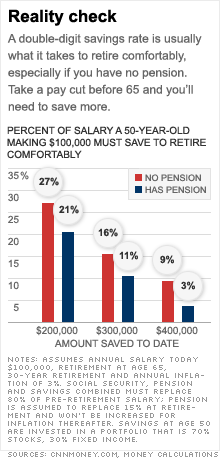5 steps to rescue your retirement
You may be down, but you're certainly not out. These five strategies will help repair the cracks in your portfolio and make sure your money lasts as long as you do.


(Money Magazine) -- Will I ever be able to retire now? That's a question you're likely asking yourself these days. After a year in which your 401(k) has been hammered by the biggest stock losses since the Great Depression, your home equity has been whacked by the collapse of the real estate market and the specter of being laid off looms larger every day, no one can blame you for being skeptical.
In fact, more than two-thirds of the respondents in a recent poll CNNMoney.com poll said they'll have to postpone their retirement as a result of the current financial crisis; more than a third worried that they'll be chained to their desks for life.
Now for the good news: You've got more weapons at your disposal to win the battle against a hostile economy than you may imagine. Read on for specific strategies to help you position your portfolio for a rebound, take advantage of other financial assets in your arsenal and make the most of the time you have left in the work force.
Sure, the task would be a lot easier if you had 25 years or more before quitting time. But while the challenges are great, so are the opportunities for a comeback.
Need convincing - and inspiration? Check out these profiles of people who lived through similar crises in the past - portfolios down by half in market crashes and recession-fueled layoffs - took smart action and ended up in better financial shape than they were before.
One thing's for sure, though: The task before you won't get any easier if you delay. Here's how to get started on your retirement rescue mission.
Assuming that you will not be able to retire when and how you planned is vastly different from knowing it for a fact. If you haven't taken count of how much money you have and how much you'll need to retire comfortably, you may be in the dire straits that you fear - or you could be in far better shape. Either way, to figure out a plan for where to go from here, you first need to know where you are right now.
Assess the Damage. This is no time to be squeamish. Dig up your latest 401(k) statement, along with the most recent statements from your bank and brokerage accounts, and add up what you've got. The extent of your losses may depress you - a typical 401(k) invested 60% to 70% in stocks and the rest in bonds is likely to be down 20% to 30%, and a more stock-heavy portfolio will have even steeper drops. But knowing the current value of your portfolio will help you determine how much you have to save going forward.
You'll also need to make an educated assumption about how much you will earn on those investments in the future. Coming out of past long-term slumps (the carnage is not just over the past year; this is, in fact, one of the worst 10-year periods on record), stocks have returned no less than 7.2% annually over the following decade and as much as 15.6%, according to the Leuthold Group.
In estimating future returns, err on the conservative side. "If you've got at least a 10-year time horizon and a balanced portfolio, a 7% rate of return is reasonable," says Chris Cordaro, a financial adviser in Morristown, N.J. While that may not sound like much, remember that you won't have to count on your investments alone to fund a comfortable retirement.
Tally other sources of income. Social Security will likely make up at least 20% of your retirement income. The longer you wait to collect (you're eligible at 62), the more money you'll get. Every year you delay up to age 70 adds about 8% to your payout. If you're retiring this year and you qualify for the maximum benefit, that would mean the difference between about $21,000 a year (in today's dollars) at 62 and $38,000 if you wait until 70.
You may have a pension to fall back on as well. Despite widespread reports of the demise of the traditional pension plan, roughly 70% of employees at large companies and 95% of people who work in state and local government still have access to one. (Federal employees and workers at small businesses aren't likely to be as fortunate.) If you're eligible for a pension, ask your HR department for an estimate of your projected payout at retirement. Even a seemingly piddly pension can make a major difference. An annual payout of $20,000, for example - one you might expect to collect if you earn $100,000 a year and have been with the company for 15 years - is the equivalent of saving an extra $300,000 in your retirement account, according to Steve Vernon, an actuary in Oxnard, Calif.
Rerun the numbers. Once you have all the facts, head to an online calculator like the Retirement Planner, to get an estimate of how much you'll need to save to meet your goal. The answer isn't likely to be a huge surprise - yes, repairing your beaten-up portfolio will likely involve serious saving on your part, as the chart on the right illustrates. But as the next steps show, saving more is only one of the tools at your disposal.
Having the right blend of investments is key. And yes, we do mean blend, even though you may feel that diversification let you down last year, failing to provide a cushion against losses. Instead, everything went down; some assets just dropped less than others. But diversification is a long-term strategy that pays off over a period of decades, not months or even a few years. Then too, imagine how much steeper the drop in your portfolio might have been if you hadn't had your money spread among several kinds of investments.
Stick with a mix. Still, the losses were painful enough, and the urge to get out of stocks entirely is understandable. So, at the other extreme, is the impulse to "swing for the fences" by aggressively moving into beaten-down stocks to recoup your losses by the time you retire. Both are bad moves.
Consider the all-bond strategy. It may sound safe, but a new study by T. Rowe Price shows that switching completely into fixed-income investments after a market crash would give you only a 31% chance of your nest egg lasting through retirement. "With a 100%-bond portfolio, you simply can't keep up with inflation and your own longevity," says Christine Fahlund, senior financial planner at T. Rowe Price.
But an outsize bet on stocks to revive your portfolio isn't smart either. Even if after the past year's losses you still have a hefty amount socked away, you don't need to take the extra risk. And if you're way behind on your savings goals, it's a risk you can't afford, especially if you're within a decade of retirement. The probable payoff is just too slim.
T. Rowe ran the numbers for a 55-year-old with a $100,000 salary and just $150,000 in savings who ratcheted up his stock allocation from 40% to 80% to help his portfolio recover. After running 10,000 market scenarios, the researchers found that while the portfolio invested 40% in stocks replaced an average of 27% of the investor's salary in retirement, the 80%-stock allocation replaced only 28% - virtually no difference. That's because while stocks have historically delivered higher returns over very long periods, over any 10-year period you're more likely to suffer a few losing years, and there simply isn't enough time for your gains to compound.
Cut your risk of big losses. As a general rule, financial advisers recommend keeping about 80% of your savings in stocks when you're in your forties, 70% in your fifties and 50% to 60% in your sixties, with the rest in bonds and stable-value funds. With stocks now at their cheapest levels in nearly two decades, those allocations give you a good shot at regrowing your portfolio going forward.
But understand, the gut-wrenching volatility of the past year isn't going away anytime soon. If the thought of watching your portfolio swoon after the Dow drops 500 points in a day - again - keeps you awake at night, it may be worth it to dial back that commitment to stocks somewhat.
Yes, you'll sacrifice a bit of your potential gains. But you'll also dampen the magnitude of the losses you could suffer - a particularly important consideration if you're within 10 years of retirement. A portfolio invested 70% in large U.S. stocks and 30% in bonds historically has averaged gains of 8.9% a year vs. 8.2% for a fifty-fifty mix, according to Ibbotson Associates. How much safety does that seven-tenths of a percentage point buy you? The worst loss in a single year for the evenly split portfolio was 24.7% vs. 32.3% for the bigger stock portfolio.
As you get closer to retirement, also try to beef up your cash reserves. Keeping two to three years' worth of living expenses in CDs or money-market funds means you won't be forced to sell stocks or bonds when they're down.
Reduce your tax bite. One surefire way to boost the real return on your portfolio is to reduce Uncle Sam's cut. Today tax rates are at multi-decade lows, but given the projected $1 trillion federal deficit this year, most experts don't expect that to last.
You can take advantage of today's low rates by saving for retirement in a Roth IRA or the new Roth 401(k), either by funneling new contributions into these accounts or by converting an existing IRA. With a Roth, you pay taxes up front on the money you put in but no taxes on your withdrawals. With traditional IRAs and 401(k)s, you get an up-front break, but your withdrawals are taxed at your regular income tax rate. Says Ed Slott, a C.P.A. and IRA adviser in Rockville Centre, N.Y.: "The sooner you get rid of Uncle Sam as a partner in your retirement account, the better."
A married couple can invest $5,000 a year per person ($6,000 if you're over 50 years old) in a Roth IRA as long as your joint income is $166,000 or less. There are no income limits for Roth 401(k)s, but only 25% of companies currently offer them, according to Hewitt Associates. That's likely to reach 50%, though, in a couple of years' time.





